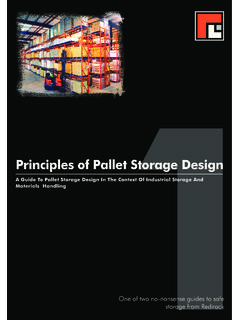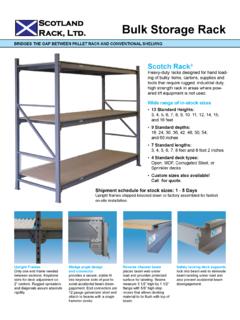Transcription of Principles of Pallet Storage Design - redirack.co.uk
1 A Guide To Pallet Storage Design In The Context Of Industrial Storage And Materials HandlingPrinciples of Pallet Storage DesignOne of two no-nonsense guides to safe Storage from RedirackA guide to the basic Principles of Pallet Storage Design , in the context of modernindustrial Storage and materials handlingTHE Principles OF Pallet Storage DESIGNF oreword Page 4 What is a store? 5 How wide? 8 Which Pallet ? 9 How high? 12 Pallet rack layout 15 Which Pallet , which rack ? 18 How much can be stored? 19 Alternative Pallet Storage layouts 22 CONTENTSFOREWORDI ncreases in the cost of square footage, the high cost of building materials, higher labour charges, expensive equipment, and stiff penalties for late deliveries and damaged goods. The key to success in the Storage and materials handling business is, to a great part, knowing how to get over these science of Storage and materials handling is a fast-growing science. New systems and techniques come thick and fast. But a close look at the science will reveal a basis of simple fundamentals and good old fashioned title of this booklet, The Principles of Pallet Storage Design , may sound much like that of a complicated textbook.
2 Far from being complicated, it is like the science it is about, mostly common-sense. Although only a very concise guide to basic Principles , this booklet will provide you with the basic formulae necessary either for designing a working Storage installation, or for improving an existing won t, of course, turn you overnight into a leading Storage and materials handling expert. But it will, we hope, help you over some of those hurdles that exist in the business of building and operating a successful Storage we can begin to analyse stores, Storage methods, materials handling and so forth, we must know what a store is. And we must identify the unique characteristics which make it a help us arrive at a defi nition, let us take a simple store, found in every household. The most common Storage item in a house is the cold water Storage tank, found normally in the roof comes into the tank from the mains, the water is held in the tank and is then drawn off through various we can see three of the basic characteristics of a store - water comes IN (goods come in) the water is HELD (goods are stored), the water goes OUT (goods go out).
3 IN HELD OUTThe next distinguishing features of a store is why the water is us look at what happens when we draw water off. Sometimes no water is drawn off. One may turn on a tap. A toilet is fl ushed, and somebody runs a bath. These things can happen individually, at any time, or all together, or, one single demand can be combined with any other demand. In other words, the demand for water in a household varies from nothing, to all taps running at the same , water comes in from the Main at a constant rate. So it would be impractical to expect the water from the Main to meet this widely varying demand. At times, if all taps were being used, the pressure would be very low and each user would get very little the water tank acts as a BUFFER between the fl uctuating demands for water, and the rate of supply of water. Notice we have built up the defi nition of a store - A STORE HOLDS GOODS AS A BUFFER BETWEEN THE FLUCTUATIONS IN SUPPLY OF THE GOODS AND THE DEMAND FOR THE throughputAlthough the function of a store is to hold goods, the way In which goods fl ow through a store affect the method in which they are held.
4 In particular, goods come in and go out in the following manner: BULK IN BULK OUTINDIVIDUAL IN INDIVIDUAL OUTSETS IN SETS OUT Any alternative in the way the goods come in,shown in the fi rst column, can be combined with any alternative in the way goods go out, shown in the second column. To make matters more complicated, in any store there can be several of these combinations operating at once. Take for example, a factory where at the end of the production line, coils of wire are stacked on to a Pallet of half a ton or one ton capacity. They are moved into the store on a Pallet , so we have BULK IN. Ideally despatches to customers are made in Pallet loads, so we get BULK IN BULK OUTH owever, there are times when an individual coil has to be despatched to a customer, and this is a case of BULK IN - INDIVIDUAL another factory where pneumatic tools are assembled. Bulk supplies of components come in from suppliers. In the stores different components are selected and put together on to a tray to make up a completed tool, so here we have BULK IN - SETS we consider a Pallet racking beam or a Pallet racking frame as one item, then at the end of the production line individual items are transferred to the store where they are put together to meet an order, so we have INDIVIDUAL IN - BULK course some items are either too large or too valuable to be moved other than in individual form, large diesel engines that go into mining equipment.
5 These are moved into, and out of store normal circumstances it is rare to get a SETS IN - BULK or INDIVIDUAL OUT. This most common occurrence of sets is in the outward movement, but the above is theoretically one exception to these defi nitions of fl ow is when the holding operation is the prime function and the fl ow through is insignifi cant. An example of this is where the goods are held for an aging process, where for example, whisky may be kept in store from fi ve to fi fteen years. Measuring performanceThere are four criteria we can use in measuring the performance of a Use of volume. 2. Ease of Ease of handling. 4. Preservation of the quality of Use of volume is a statement of how much cubic capacity is effectively being used out of the total amount available, the volume of the goodsWHAT IS A STORE?stored compared with the volume of the building length x breadth x height. Ease of selection - indicates all those factors which go to the identifi cation of the location of the goods stored, both for putting away into the stores, and for getting them out to meet despatch requirements.
6 Ease of handling describes those factors that affect the handling of goods, whether mechanical handling is required, whether double handling is involved, the speed of handling, etc. Preservation of the quality of goods relates to deterioration of the goods, either by accidental damage, age, as with vegetables for example, or deterioration because goods go out of style, fridges, cookers (which although fairly robust in themselves do have changing styles ).Now these factors are all inter-related. Any action to improve one factor will most likely adversely affect the simple theoretical example can demonstrate this. Imagine you have a simple cubic building with one door into it. If you fi ll this building up completely, you will make excellent use of volume. However, if you have more than one type of item stored in there, then it would be extremely diffi cult to select the item you want. So what happens?Do you start creating gangways to improve the selection of goods? This will immediately reduce the use of the you require mechanical handling the gangways need to be even wider, reducing the volume, and there is always a danger that with mechanical handling the rate of damage to goods course, you might fi nd that by block stacking the lower items will be crushed, so you may decide either to store only one-high with the consequent reduction in volume, or put the goods on racks, which also reduces the amount of volume effectively most common plea from someone investigating an effi cient store is that he needsmore space.
7 In practice this is rarely so. There is usually enough volume to cater for the goods he stores. It is more likely that the requirement is infact, for improved handling, improved selection ofgoods (whether putting away or despatching), or forincreased protection of the goods. This is why great care must be taken to identify the more important factors relating to the optimum effi ciency of the a simple example relating to the use of volume, imagine a building 30 m long by 14m wide by 7m high to the inside of the ceiling obstructions, that is 2940 cubic capacity of layout:1 block 22 pallets x 6 pallets x 4 pallets high = 528 pallets2 blocks 10 pallets x 5 pallets x 4 pallets high =400 palletsTOTAL: 928 palletsEach Pallet uses cubic 1392 cubic metres of Storage is utilisedin 2940 cubic metres usage!That allows only 42 different lines to be stored and assumes every single space can be used, which will not be the case in AND LOAD DETAILSWhen considering Storage equipment to be used with uprights we need to go back to basics.
8 The function of Adjustable Pallet Racking is to store goods on pallets. Therefore, the physical parameters of the pallets affect the racking used. The weight-carrying capacity of Pallet racking is a specifi c instance of a general principle. The affects of the weight of the load can be traced through all the structural members of the racking down to the fl oor, and every structural member must be considered as follows:At this stage we are considering wooden pallets only. Pallets are objects which permit goods to be moved mechanically by fork lift trucks. These goods may be single units or a multiple of items, but normally the load is such that it cannot easily be carried manually, and the use of a fork lift truck effects cost Pallet must have a deck on which to carry goods, a space into which forks can enter, and a support on the ground. Because the thickness of forks entering the Pallet is of the order of 50 mm thegap between the top and bottom decks is usually used in conjunction with racking, pallets normally rest on beams (they of course could rest on solid shelving but this would be an expensive way of carrying the load).
9 Consequently the underside of the Pallet , which is the interface between Pallet and beam, is most important. Pallets are frequently described as two-way or four-way entry, which means that the forks can either enter on two sides or four, as the sketch the following section, WHICH Pallet ?, we take a closer look at pallets and Pallet types, the choice of which will ultimately dictate to a larger extent, the width of racking to be PRINCIPLELOADSHELVINGBEAMS (IF USED)UPRIGHTSFLOORPALLET RACKINGLOADPALLETSBEAMSFRAMESFLOORHOW WIDE? Pallet components - standard terms and defi nitionsTWO-WAY ENTRYHere the bearers permit the entry of forks or fi ngers from two opposite directions only. The sides through which the forks enter are called entry sides .FOUR-WAY ENTRYThe bearers (or blocks) permit entry of forks or fi ngers at each end and at each side. The sides through which the load wheels of a Pallet truck can pass without leaving the ground are known as free entry sides . The other sides, where the load wheels have to pass over the bottom slats are termed restricted entry sides.
10 BEARERSM embers under the top deck or separating the top and bottom decks, which provide a space for the entry of forks or fi ngers. They may consist either of longitudinal members or distance pieces (usually known as blocks).DECKThe top or bottom fl at surface which may be solid or MEMBERSM embers forming the outside edges of decks on the sides in which the forks or the fi ngers horizontal member connecting the bearers and supporting the permitting the entry of forks or fi ngers in a particular parts of the deck or decks which project beyond the rebated angle in the structure of a Pallet , in particular on the edges of the bottom deck, to facilitate the passage of the load wheels of a Pallet SIZES FOR FLAT PALLETSThe British Standards Institution has selected the following plan dimensions for standard pallets: 800 mm x 1200 mm, 1000 mm x 1200 mm, 1200 mm x 1200 mm, 1200 mm x 1800 mm ( 2629 1967)The International Organization for Standardization has also recommended the above sizes and proposed the following plan sizes as international standards for maritime use.





